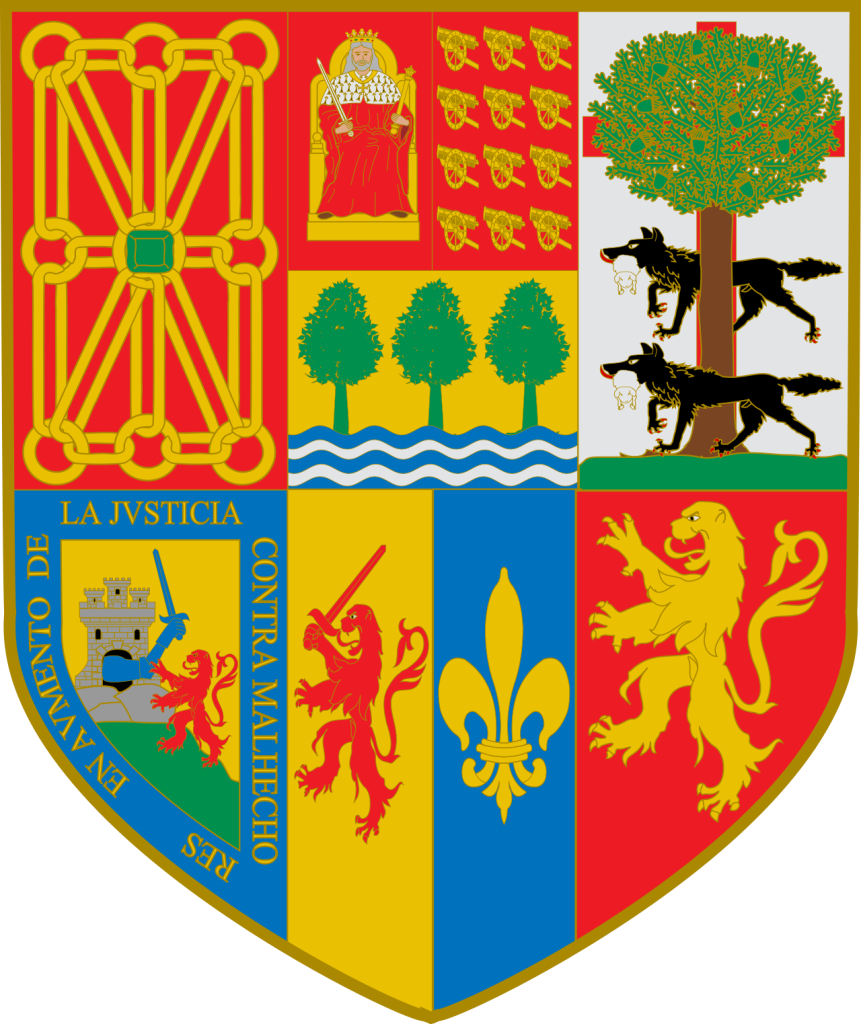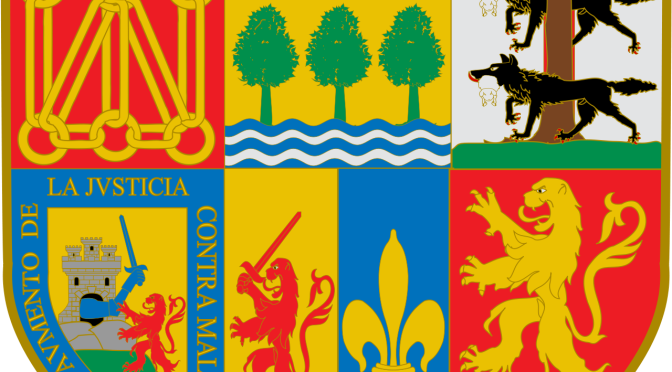The phrase Zazpiak Bat – the seven [are] one – signifies the unity of the seven Basque provinces – four in Spain and three in France. It is also the nickname of the Basque coat of arms – the Euskal Harmarriak. But wait, there are only six panels in the coat of arms! Hold on… I see the seventh… the red lion and the fleur-de-lis are two separate ones, representing two different provinces, right? Nope! So, what’s going on here…?

- Though there are seven Basque provinces, there are only six fields on the Zazpiak Bat. That’s because Nafarroa and Nafarroa Beherea share the first field, the chains of Nafarroa. The chains first appeared during the reign of Theobald I of Nafarroa, in the early-to-mid 1200s. Legend says that the chains, and the emerald that sits in the middle, represent the chains broken and the emerald captured during the Battle of Las Navas de Tolosa in 1212.
- Next comes the coat of arms of the province of Gipuzkoa. The original design, dating back to 1466, had a king on his throne holding a sword in the upper half and three trees, likely yews, above the sea in the lower half. The king is likely either Alfonso VIII or Enrique IV, while the trees represent the inherent nobility of the people. In 1513, twelve cannons were added to upper panel, to the right of the king (as illustrated here). They represent the cannons captured during the Battle of Belate the year before. In a decision made in 1931 but not enacted until 1979, the king and cannons, representing monarchy and feudalism, were removed. The official coat of arms of the province now only contains the trees and the sea. Some versions of the Zazpiak Bat have the older version while some have the newer version.
- The last field on the top row comes from Bizkaia. There are again a couple of versions. The actual coat of arms of the province has the tree of Gernika superimposed on a silver cross surrounded by eight red Xs (or saltires). Before 1986, Bizkaia’s coat of arms also included two black wolves, each with a lamb in its mouth, representing the House of Haro. Legend has it that two wolves crossed Jaun Zuria’s path before his victory at the Battle of Arrigorriaga. Sabino Arana suggested that the wolves represented monarchy and was anathema to the Basque spirit, so they were eventually dropped.
- First on the bottom row is the coat of arms of Araba. Around the edge is written “en aumento de la justicia contra malhechores” meaning “in heightened justice against wrongdoers.” There is a castle upon a rock with an armored arm holding a sword sticking out of the rock, defending the castle against a rearing red lion. The castle represents Portilla Castle, an important defensive point in the Kingdom of Nafarroa. The appearance of the castle in Araba’s coat of arms dates back to the 13th century.
- Lapurdi comes next. Its coat of arms consists of a red lion holding a sword or a dart on a gold background and a gold fleur-de-lis on a blue background. These were directly taken from the coat of arms of the town of Uztaritze when it became capitol of the province. The lion likely represents the rulers of the region and the fleur-de-lis represents the union with France under Charles VII.
- Finally comes Zuberoa, which is a gold lion on a red background. It was originally the coat of arms of the lord of Mauléon, the capital of the province.
- The Laurak Bat, the coat of arms of the Basque Autonomous Community (BAC), comprised of Gipuzkoa, Bizkaia, and Araba, has three fields for those three provinces, plus a fourth blank red field. Until 1986, the last one contained the chains of Nafarroa, but the government of Nafarroa filed suit and the Spanish Supreme Court ruled in 1986 that the BAC could not use the chains any longer.
- There are lots of variants of the Zazpiak Bat as it isn’t the official coat of arms of any specific legal entity. The order of the fields changes from version to version and so too does the detail of each specific field.
Primary sources: Coat of arms of Basque Country (autonomous community), Wikipedia; Zazpiak Bat, Wikipedia; Eusko Harmarriak by John Ysursa, Buber.net
Discover more from Buber's Basque Page
Subscribe to get the latest posts sent to your email.



My father came from the province of Navarra, which Basque area is that?
it is the biggest province, sort of the southeastern part of the Basque Country. If you search for Navarre you should find a map that highlights exactly where it is.
I know where it is, but I don’t see it listed on your list of 7 provences. Could you give me the Basque name for Navarre?
ah, sorry. In Basque, it is Nafarroa and it is the first one in the picture.
Greetings Ron Arrache,
Did your father come from the Navarre province in Spain or the Basse Navarre in France? The capital of the Basse Navarre in France is Saint Jean ( John in English) Pied de Port. The other Basque province in France is Labourd and the capital is Ustaritz.
You may be able to find some information as many municipalities put their archives on line.
Good luck.
Monique